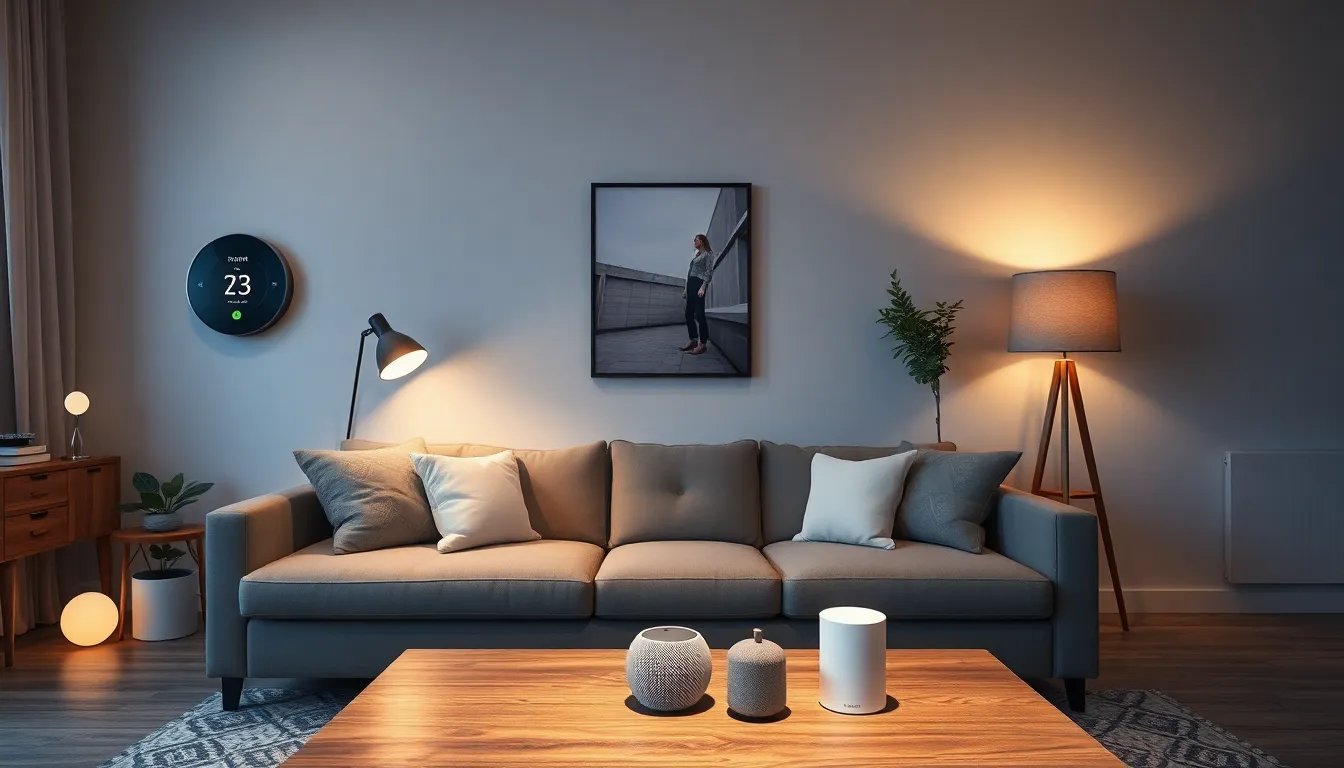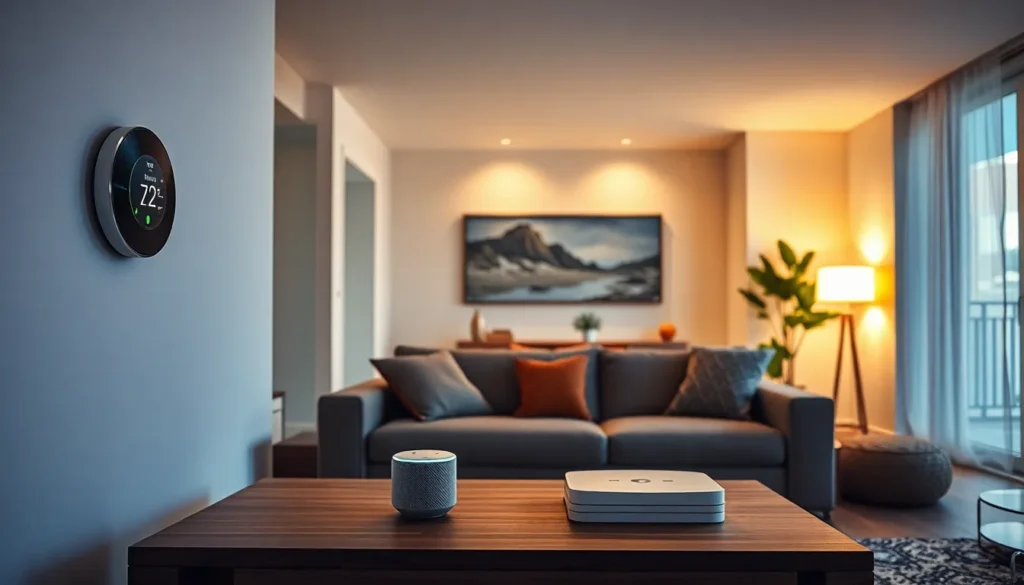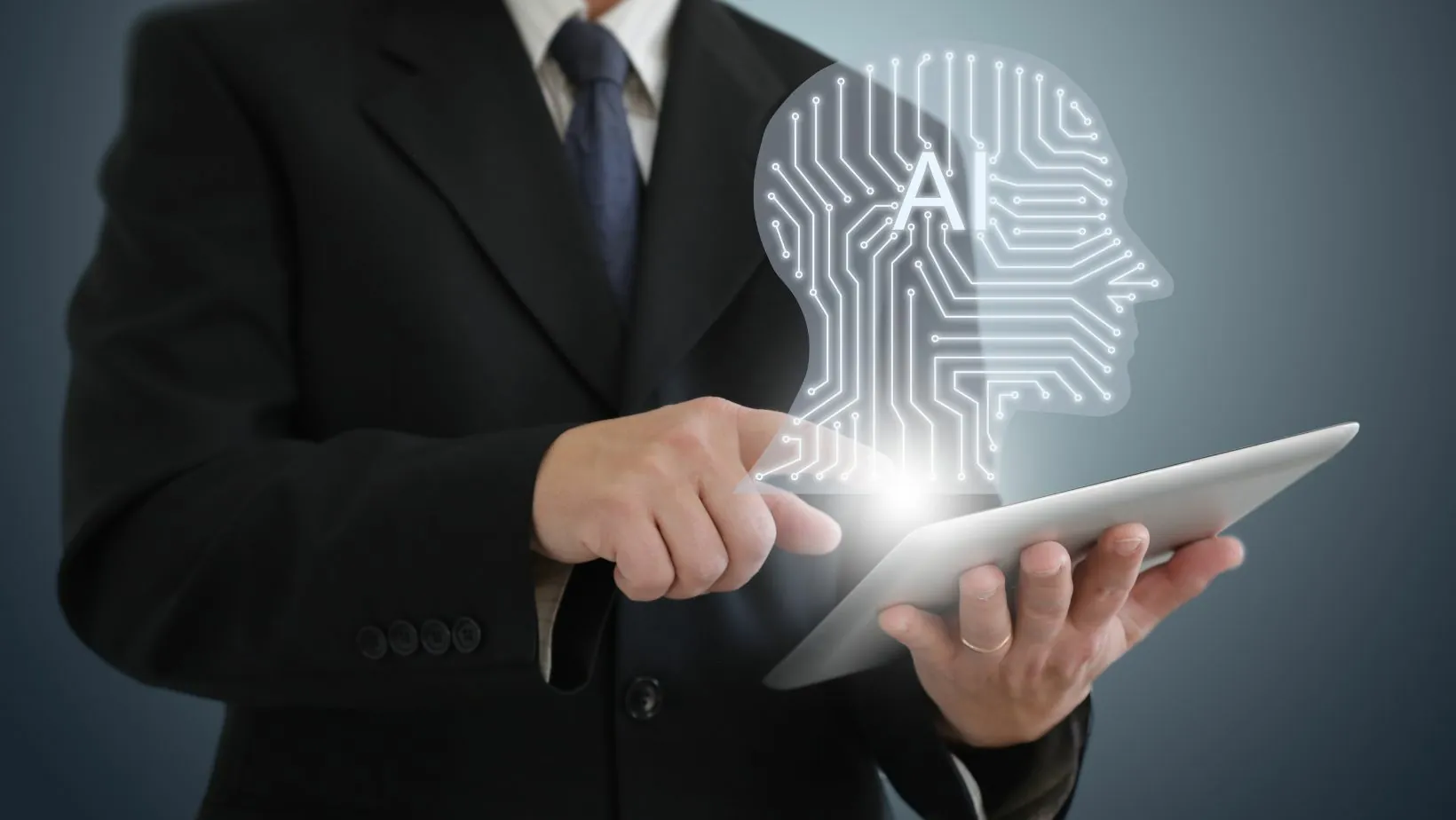Table of Contents
ToggleIn today’s fast-paced world, automated home devices are transforming the way people live. From smart thermostats to voice-activated assistants, these technologies simplify daily tasks and enhance comfort. Homeowners are increasingly embracing automation to create a more efficient and enjoyable living environment.
As connectivity improves and technology advances, the market for automated devices continues to grow. These innovations not only save time but also promote energy efficiency, making them an attractive option for eco-conscious consumers. With endless possibilities, automated home devices are redefining modern living and setting new standards for convenience and security.
Overview of Automated Home Devices
Automated home devices serve as essential tools in modern residences. These devices encompass a range of smart technologies designed to enhance user convenience, efficiency, and security.
Categories of Automated Home Devices
- Smart Thermostats
Smart thermostats adjust heating and cooling settings automatically based on user preferences or occupancy patterns. Popular models include the Nest Learning Thermostat, known for energy-saving features, and ecobee, which includes sensor technology for temperature control across multiple rooms.
- Voice-Activated Assistants
Voice-activated assistants, such as Amazon Echo and Google Nest Hub, facilitate hands-free management of smart home devices. These assistants allow users to control lighting, music, and more, using simple voice commands.
- Smart Lighting
Smart lighting systems provide users with control over the brightness and color of their home lighting. Brands like Philips Hue and LIFX offer customizable settings that can automate lighting schedules or respond to environmental changes.
- Security Systems
Automated security devices, such as smart cameras and doorbells, enhance home security. Companies like Ring and Arlo offer systems with real-time video feeds and motion detection alerts.
- Home Appliances
Smart home appliances, including refrigerators, ovens, and washing machines, improve kitchen and laundry efficiency. Brands like Samsung and LG integrate smart technology to provide remote control and monitoring capabilities.
Benefits of Automated Home Devices
Automated home devices offer various benefits. Users experience increased energy efficiency through smart temperature control and lighting automation. Convenience improves as these devices simplify everyday tasks, such as grocery management and security monitoring. Enhanced safety measures also protect residents while providing peace of mind through integrated surveillance features.
Overall, automated home devices represent a significant advancement in residential technology, providing solutions that adapt to the lifestyles and needs of users.
Benefits of Automated Home Devices

Automated home devices significantly enhance everyday living by providing convenience and security. These technological advancements cater to modern lifestyles, ensuring a seamless experience.
Improved Convenience
Automated home devices streamline daily tasks. They enable remote control of various systems. For example, smart lighting adjusts brightness and color with a simple voice command or app click. Smart thermostats optimize heating and cooling according to user schedules, ensuring comfort while saving energy. Voice-activated assistants facilitate hands-free management. Users can make shopping lists, set reminders, and control smart devices without using their hands. Automated plants watering systems, for instance, can be scheduled to ensure proper care without manual effort. Overall, these features simplify household management, allowing users to focus on more important tasks.
Enhanced Security
Automated home devices significantly improve home security measures. Smart cameras offer real-time monitoring, sending alerts directly to the homeowner’s smartphone upon detecting unusual activity. Home security systems integrate door sensors, window sensors, and cameras to create a comprehensive safety network. Smart locks enhance access control, allowing users to lock or unlock doors remotely and grant access to visitors without being present. Security lighting adjusts based on movement, illuminating areas to deter potential intruders. When integrated, these systems provide peace of mind, ensuring homeowners can monitor their property from anywhere at any time.
Types of Automated Home Devices
Automated home devices come in various forms, each enhancing daily living through technology. Here are some popular types of these devices:
Smart Lighting Systems
Smart lighting systems offer customizable brightness and color choices for energy efficiency. Users can control their lights via voice commands or mobile apps, scheduling them to turn on or off at specific times. Many systems integrate motion sensors, automatically adjusting lighting based on occupancy. Examples include Philips Hue and LIFX, which provide various smart bulbs and fixtures.
Thermostats and Climate Control
Thermostats and climate control devices automate temperature management within homes. Smart thermostats like Nest and Ecobee learn user preferences, adjusting heating and cooling accordingly. Users can remotely control these systems through apps, optimizing energy use and maintaining comfort. Some models incorporate occupancy sensors, enhancing energy efficiency further by reducing heating or cooling when no one is home.
Security Cameras and Alarms
Security cameras and alarms create a safer living environment through real-time monitoring. Smart cameras, such as Canary and Ring, send alerts for unusual activities and allow users to view live footage from mobile devices. Alarm systems integrate with other home devices, enhancing security through automated responses to potential threats, like locking doors if an alarm triggers.
Voice Assistants
Voice assistants simplify home management through hands-free control. Devices like Amazon Echo and Google Nest Hub enable users to ask questions, control smart devices, and manage tasks seamlessly. These assistants integrate with various home systems, allowing users to adjust lighting, check the weather, or control the thermostat with simple voice commands.
Challenges and Considerations
Automated home devices present various challenges and considerations. Addressing these issues ensures a smoother integration into daily life.
Privacy Concerns
Privacy concerns persist with automated home devices. Many devices collect user data, raising questions about data security and personal privacy. Manufacturers often store information about user habits, potentially exposing it to third-party access or breaches. For instance, smart speakers actively listen for voice commands, leading to apprehensions about inadvertent recording. Users must review privacy policies and adjust device settings to limit data sharing.
Compatibility Issues
Compatibility issues frequently arise with automated home devices. Not all devices work seamlessly with each other, complicating integration into a cohesive smart home ecosystem. For example, a user may find that a smart thermostat isn’t compatible with their existing heating system. Manufacturers often utilize proprietary protocols, making it difficult for consumers to combine devices from different brands. Researching compatibility before purchasing devices ensures a functional and streamlined smart home experience.
Future Trends in Automated Home Devices
Automated home devices are evolving rapidly, driven by advancements in artificial intelligence and machine learning. These technologies enhance the capabilities of devices, allowing them to learn user habits and preferences, resulting in personalized experiences.
- Increased Interoperability
Increased interoperability among devices presents a trend toward seamless integration in smart home ecosystems. Manufacturers focus on developing standards that enable various devices to communicate effectively, ensuring users can operate different systems together without issues.
- AI-Powered Automation
AI-powered automation improves efficiency by enabling devices to anticipate user needs. Automated systems can adjust settings based on routines, such as automatically lowering blinds in the evening or adjusting temperature settings as users arrive home.
- Enhanced Security Features
Enhanced security features continue to emerge, addressing user privacy concerns. Advanced encryption methods and biometric authentication are now commonplace in smart locks and cameras, providing an additional layer of protection against unauthorized access.
- Sustainability Initiatives
Sustainability initiatives mark a significant trend in the development of automated home devices. Energy-efficient appliances and smart thermostats contribute to reduced energy consumption, aligning with global efforts to combat climate change. Sensors in these devices monitor usage patterns, further optimizing energy efficiency.
- Voice Control Advancements
Voice control advancements expand beyond basic commands to include complex interactions. Natural language processing improvements allow devices to understand context and execute multi-step commands, enhancing user experience and accessibility.
- Integration with Health Monitoring
Integration with health monitoring systems reflects growing consumer interest in wellness. Automated devices can now track air quality, humidity levels, and energy consumption, ensuring a healthier living environment.
- Remote Monitoring and Management
Remote monitoring and management capabilities are becoming standard features. Users can access their automated home systems via mobile apps, enabling real-time adjustments and monitoring, even while away from home.
- Customization and Personalization
Customization and personalization options expand as users seek unique experiences. Automated devices allow for tailored settings, such as adjusted lighting colors in response to specific activities, enhancing both functionality and ambiance.
These trends indicate a robust future for automated home devices, focusing on integration, efficiency, and enhanced user experience. Continued innovation and adaptation to consumer needs will shape the landscape of home automation technology.
Automated home devices are transforming the way people live by simplifying routines and enhancing comfort. As technology continues to evolve, these devices offer unprecedented convenience and efficiency in daily tasks. The potential for improved security and energy savings makes them increasingly appealing to homeowners.
However, it’s crucial for users to remain aware of privacy and compatibility issues that may arise. With the right research and considerations, individuals can create a seamless smart home environment tailored to their needs. The future of automated home devices looks promising, with advancements in AI and machine learning paving the way for even more personalized and integrated experiences. Embracing these innovations can lead to a more efficient and enjoyable living space.



